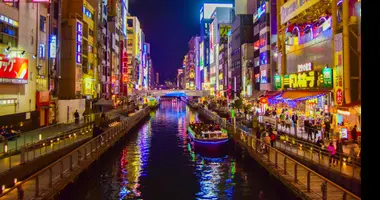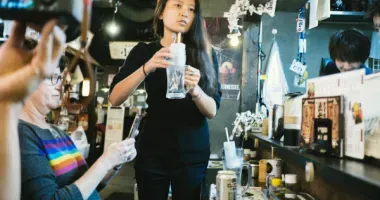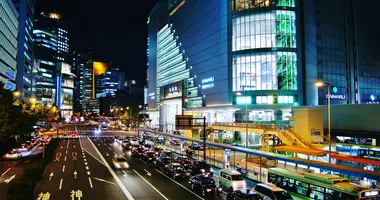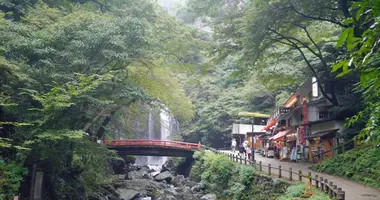Japanese Garden at Osaka Expo Park
The Japanese Garden at Expo Park in Osaka were built for the World Expo of 1970 and introduce foreign visitors to traditional Japanese garden types.
The Japanese Garden at Expo Park, Osaka - 万博記念公園
The Japanese Gardens at the Expo Memorial Park in Osaka are less than 50 years old, yet for those with an interest in traditional Japanese gardens it has a lot to offer as it showcases the many different styles of garden that have been enjoyed by the Japanese over the past 1,000 years or more.
 The Japanese Garden at Expo Park
The Japanese Garden at Expo Park The view from the rest house at the Japanese Garden in Expo Park, Osaka
The view from the rest house at the Japanese Garden in Expo Park, Osaka
Osaka Expo Park
The gardens were built for the World Expo of 1970, and meant to introduce foreign visitors to the variety of traditional garden types throughout Japanese history, and is really four different gardens which flow into each other.
Consequently it is much bigger than other gardens, measuring 1,300 meters from east to west and about 200 meters wide covering 64 acres in total. It was designed by Taji Rokuro who was also responsible for the Osaka Castle Park. The four styles are Ancient, Medieval, Early Modern and Modern.
 Medieval style garden, Japanese Garden, Expo Park
Medieval style garden, Japanese Garden, Expo Park  Bridge over the karesansui garden at the Japanese garden in Expo Park, Osaka
Bridge over the karesansui garden at the Japanese garden in Expo Park, Osaka
Ancient Garden
The ancient style of garden dates from the Heian Period (794-1185), and like much of the culture of the ruling elite of Japan, the design of the gardens were introduced from China.
This style of garden usually included a water source such as a spring or small waterfall, with jagged rocks representing mountains and flat areas along the watercourse representing beaches.
Famous gardens of this style can be found at the Byodo-in in Uji and at Shinsen-en in Kyoto.
Medieval Garden
The medieval style of garden is from the Kamakura and Muromachi periods of the 12th to 16th centuries.
The greatest influence on garden design in this period was the introduction of Zen Buddhism. This was when the karesansui, the dry gardens, were first introduced, with raked sand used to represent water.
 Yaezakura cherry blossoms at the Japanese garden in Expo Park, Osaka
Yaezakura cherry blossoms at the Japanese garden in Expo Park, Osaka
This was also the time of the flowering of tea culture and the tea ceremony so many gardens incorporated one or more tea houses into their design. The world famous garden at Ryoan-ji in Kyoto and the one at Daisen-in, a sub-temple of Daitokuji, also in Kyoto, are excellent examples from this period.
Early Modern Garden
Early Modern refers to the period from the 17th century until the 19th century and is often referred to as either the Edo Period or the Tokugawa Period.
 View across the biggest pond to the Rest House in the Japanese Garden at Expo Park
View across the biggest pond to the Rest House in the Japanese Garden at Expo Park
This was the time of the Chisen Kaiyushiki style of strolling garden and many daimyo (feudal lords) built quite large ones that are more park-like.
Usually featuring a largish body of water around which paths took the visitor in and out of different sections and offered different views.
Many features from earlier garden styles are often incorporated. Often found in close proximity to the castle, famous examples would be Koraku-en in Okayama City and Kenroku-en in Kanazawa.
Modern Garden
The Modern style of garden is a twentieth century creation. Obviously influenced by formal gardens of the West, for the first time Japanese gardens became "abstract", that is to say that up until this time the gardens were representations of landscapes, sometimes real landscapes, sometimes imaginary landscapes, in a similar way that a painting can be a representation of a landscape, but now a garden could just refer to itself and a whole new set of criteria could be used in its design.
The garden here at the Expo Park includes elements from all for historical styles and is therefore a wonderful place to begin if you are new to Japanese gardens and want to start to make sense of them.
The English language pamphlet offers full explanations. There are three tea houses within the grounds. The smaller ones are only open during November during the maple viewing period, but the larger one is open all year round.
The matcha tea ceremony costs 500 yen per person. Throughout the seasons different colors make an appearance, plum blossoms, cherry blossoms, lotus, iris, etc.
There is also a koi pond as well as koi in the largest pond, the Shinji-ike, so named because it is in the shape of the kanji "shin" - meaning heart.
 Shinji Pond at the Japanese Garden in Expo Park
Shinji Pond at the Japanese Garden in Expo Park
Access - how to get to Expo Park
Expo Park
9-3 Senribanpakukoen, Suita, Osaka 565-0826
Tel: 06 6877 7387
Hours
Open from 9.30 am to 5 pm. Closed Wednesdays or the next day if Wednesday is a National Holiday. Closed from Dec 27th to Jan 7th.
Admission
250 yen for adults 70 yen for kids. The entry fee also includes entry to the other gardens in the Expo Park.
Expo Park is a 15 minute walk from either the Bampakukinenkoen or Koen-higashiguchi monorail stations.
The #112 Hankyu Bus from Hankyu Ibaraki-shi Station runs on weekends and public holidays to Nihon Teien Mae bus stop from where it is a 15-minute walk to the park.
The National Museum of Ethnology is also within Expo Park.
 Island in Shinji Pond of the Early Modern style garden at Expo Park
Island in Shinji Pond of the Early Modern style garden at Expo Park




















